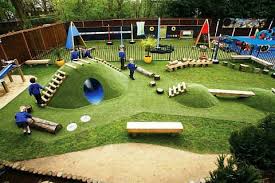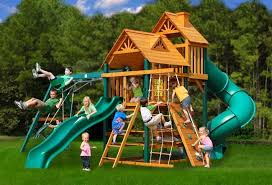
Children’s playground
Playground – a place designed for playing children, mostly pre-school age. Most often it is located in a populated area and is protected from roads. The integration of the playground into the park is optimal. The playground is an area where elements of children’s street play equipment are located in order to organize meaningful leisure activities. Playing equipment, in its turn, is a set of constructive structures that promote physical and mental development, while having a positive impact on the social adaptation of the child. Depending on the content, playgrounds are divided into: playground for a specific age group. universal playground, which includes modules for different ages. All elements of the playground must be suitable for the age, height, weight and physical abilities of the child. It is best to arrange the playground in accordance with safety requirements for play elements such as safety of materials, maximum height of free fall, safety zones. Playgrounds are designed for playing children and teenagers in outdoor street areas (yards, kindergartens, parks).
Tasks:
1.Creating a playground idea in a national style
2.Development of a general plan for the playground and drawings of the main components of the playground.
3.Development of elements of small architectural forms.
4.Development of a children’s playground layout.
5.Creating an emotionally rich and aesthetically appealing space for children.
6.Research and selection of environmentally friendly materials for the playground.
7.Design of the playground taking into account ergonomic requirements and building standards.
8.Designing a playground with safety zones for certain types of equipment.
9.Provision for active and passive play areas.
The playground is a whole world where children communicate, make friends, fight, learn the world and get the first life experience. Playground equipment, in turn, is a set of various constructive structures that promote physical and mental development, while having a positive impact on the social, psychological and cultural adaptation of the child. Properly organized playgrounds motivate children for independent physical activity, personal development and the acquisition of important skills and develop their behavioral culture.
The initial requirement for the children’s substantive and spatial environment, which determines its developing character, is the creation of conditions for a variety of activities, with a view to achieving the children’s physical and mental development and improving their personal characteristics. As a result of scientific and technical progress, the possibilities of realization of any project concepts have considerably increased, but the use of technological achievements of modern science is not an end in itself, but a means of realization of social, artistic and conceptual aspects of designing. At the heart of any design project is a certain idea, a concept, on which the visual image of the object depends, which is especially important for such an environment object as a playground. A certain social orientation of this kind of environmental objects makes adjustments to the technical requirements, based on humanitarian values and social priorities.Go to the site and find out morehttps://argoprep.com/blog/k8/math-playground/
There are several ways to erect children’s play complexes, which depend on certain factors:
- Spontaneous playground – a way popular in the 70s – 90s. Such playgrounds, still preserved in many neighborhoods, were built spontaneously, without a preliminary project, often by activists or craftsmen. The basic material was roughly treated wood or metal welded construction. The advantage of such a site was its low economic value and ease of construction, while the disadvantages were standardity, pattern, durability and inconsistency with safety standards, as well as aesthetic unattractiveness and weak thematic orientation.
- A typical playground is the most popular variant used in modern urban buildings. It is created on the basis of standard modular elements created by industrial means. Such elements make it possible to build a rather diverse and functionally rich object and space game environment. Elements are created from qualitative plywood or MDF facing plastic which are fastened on a metal welded or a modular framework. The advantage of such a site is its comparative economic accessibility, compliance with safety and ergonomic requirements, as well as brightness and attractiveness. The main disadvantage can be called a certain uniformity of figurative means of expression and limited approaches to game situations.
- The children’s playground created on the basis of an individual design project is an extremely rare variant of erection of children’s playgrounds. Rare use of this variant is connected with its lacks: the big cost, big terms of performance, technological difficulties etc. However the given way of erection is the most advantageous in connection with its advantages: an individual approach to consumers, psychological conformity, and also the bright, original image underlying the visual concept of a platform attached to various game situations.
Swings and slides, game walls and sandpits, stairs and carousels – all these attributes of child happiness must be on a good playground. They allow you to organize role-playing games, develop children’s imagination and have the most important function of the overall development of children. Children of preschool age spend quite a lot of time in the spatial environment of the playground. Therefore, on what will be this playground, depends generally not only the physical but also the spiritual development of the child. Children need movement and sport like air. That is why children’s playgrounds attract children, and their parents, as a magnet. Children’s playground – the necessary and sometimes necessary solution for new construction, cottage town, kindergarten, school, gymnasium, outdoor summer playground in the park area. The playground includes various slides, swings and much more. Playing devices for children should give freedom of imagination, instill skills of collective games, promote formation and development of art taste. Their color scheme should contribute to the urban development of cheerful flavor and diversity. All kinds of games should strengthen children’s health, nurture courage and agility. In many cities there are children’s playgrounds, decorated according to the thematic plan: fairytale fortresses, castles, terems, imitation sea, transport, space, building structures. Playing on the playground adds strength, health, agility. And, after all, it is a lively activity that a child needs so much.

Brief historical overview
Children’s play complexes, playgrounds, various sports facilities – all this contributes to the proper development of children and health promotion. Playgrounds for children have been created since ancient times. But the most popular, as now, used slides. Even in ancient Russia, slides were loved by both children and adults. Naturally, such slides, as now was not, and the service of making a slide provided weather. For a hill it was necessary only suitable hill, a lot of snow and frost. Covered slides are still in great demand. In some areas, such as Kievan Rus, there was the production of real summer slides, prototypes of modern slides. They were made of oak, and for better sliding they were lubricated with resin and bear grease. Of course, such a composition could not serve long, but gave the opportunity to “ride with the wind”. Summer children’s slides could not afford ordinary people, only the upper class of society. That’s why the winter “lollipop” enjoyed great popularity. It should be noted that this entertainment was loved not only by children but also by adults, and necessarily every winter holiday was accompanied by riding from the slide. After many centuries, the slide remains a favorite type of entertainment, mainly among children. Although it is often possible to see happy parents riding with their children from the slide. It has changed, acquired a modern appearance, become safer and is made of more reliable materials, but still popular. Basic principles of design and zoning
The children’s playground is located in the park zone. It will allow placing the playground in the shade of trees. The playground is designed for children from 3 to 12 years. For children from 3 to 5 years old provides equipment for a quiet game – sandpit, drawing boards, a low ladder for lasagna, soft bumps, swings and a children’s stage. For children from 6 to 12 years old developed equipment for more mobile games – carousels, slide, sports complex with stairs and bars. Areas for active and passive play are separated, which will reduce the risk of injury. After all, zones should not intersect in their activities. Planning structure and zoning The playground for children is located in an urban environment. At the heart of the planning idea is a bright artistic image of the national patterns and beauty of nature in Kazakhstan In the plan it is a symbol of the peak map, which is associated with the theme of the site and the large mountains of Kazakhstan The playground is divided into two zones – active and passive play. Active Zone – It has a slide house in the form of a yurt, carousels in the form of camels and horses, swings in the form of lambs and a sports complex. The passive zone represents a fairy-tale forest, On it there is a sandpit in the form of a mountain, a ladder for lasagna in the form of a caterpillar, tablets for drawing in the form of a cat and a rabbit, a scene for children with a silhouette of a cat in the background, bumps, rings for playing balls swing in the form of trees.
One of the pressing problems of modern society is the organization of leisure time of children and teenagers as a means of socialization of the younger generation, prevention of various forms of deviant (asocial) behavior. This problem acquires special importance in the period of the pupils’ vacation. The current situation requires a deeper and more structured approach to the organization of health-improvement, recreation and employment of children, since the educational, cultural and moral level of children’s development has undergone qualitative changes; the interest of children and adolescents in work has been largely lost; their health condition has deteriorated; the number of socially vulnerable categories of children has increased; and the socio-economic situation of most families does not allow them to organize their own health-improvement, recreation and employment. The various legal forms and forms of ownership of children are involved in ensuring their recreation, health improvement and employment. These include: countryside in-patient children’s health-improvement camps, day-care camps for children, tent tourist camps, labour detachments for senior pupils, specialized (specialized) sports, tourism, local history, environmental, biological and technical camps; health-improvement centres, bases and complexes, and social service establishments. In the summer period, preventive activities become topical. This is due to the fact that, during this period, the educational impact on children in educational establishments is considerably weakened or stopped. A large proportion of children spend their summer vacations either with their parents, including children’s upbringing, or in various organized areas (holiday camps, day camps, work brigades, school camps, etc.). The content of software for such areas of summer pastime is very diverse, but often does not address the issues of preventing asocial behaviour itself. As a result, in Ave.